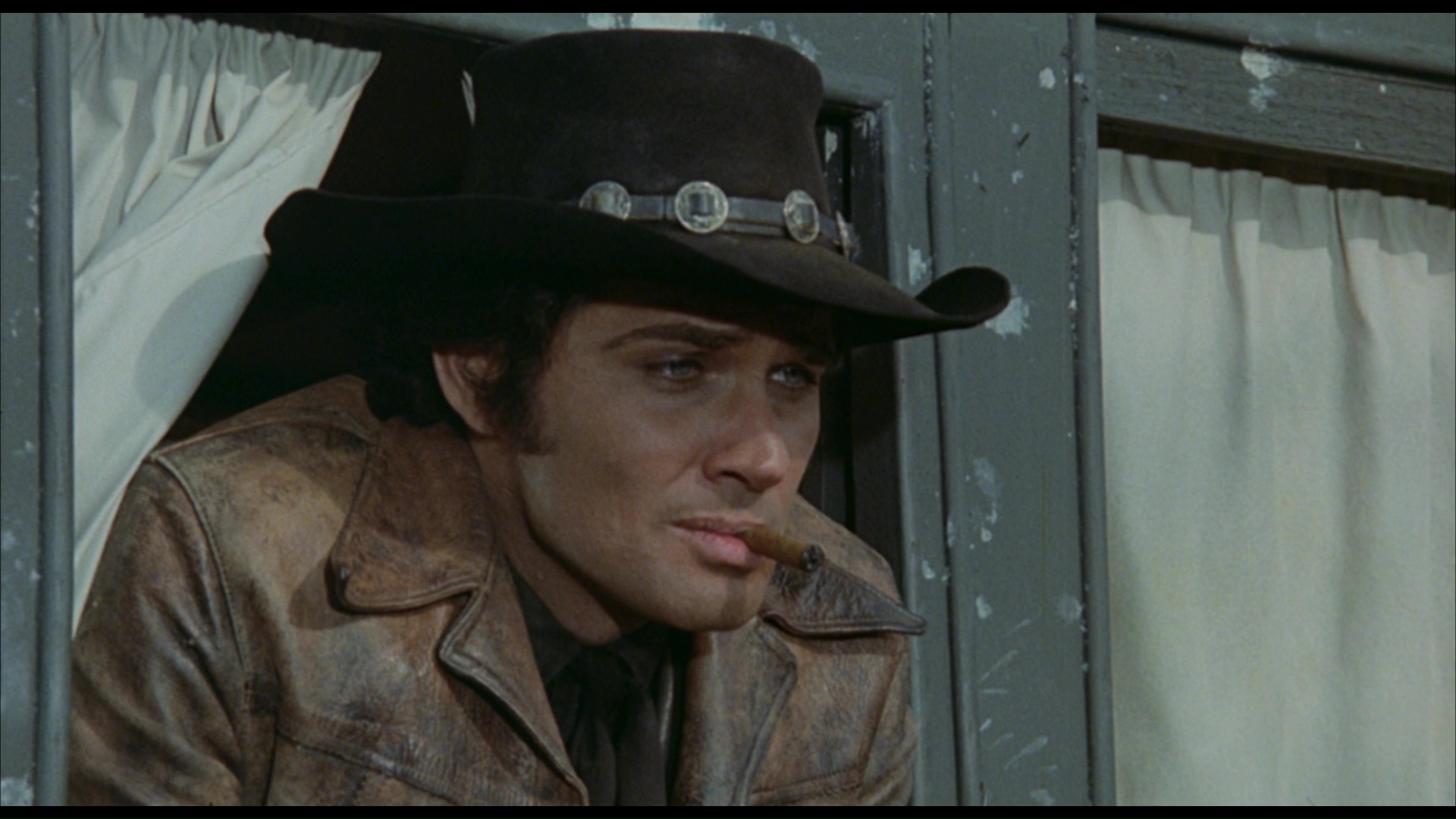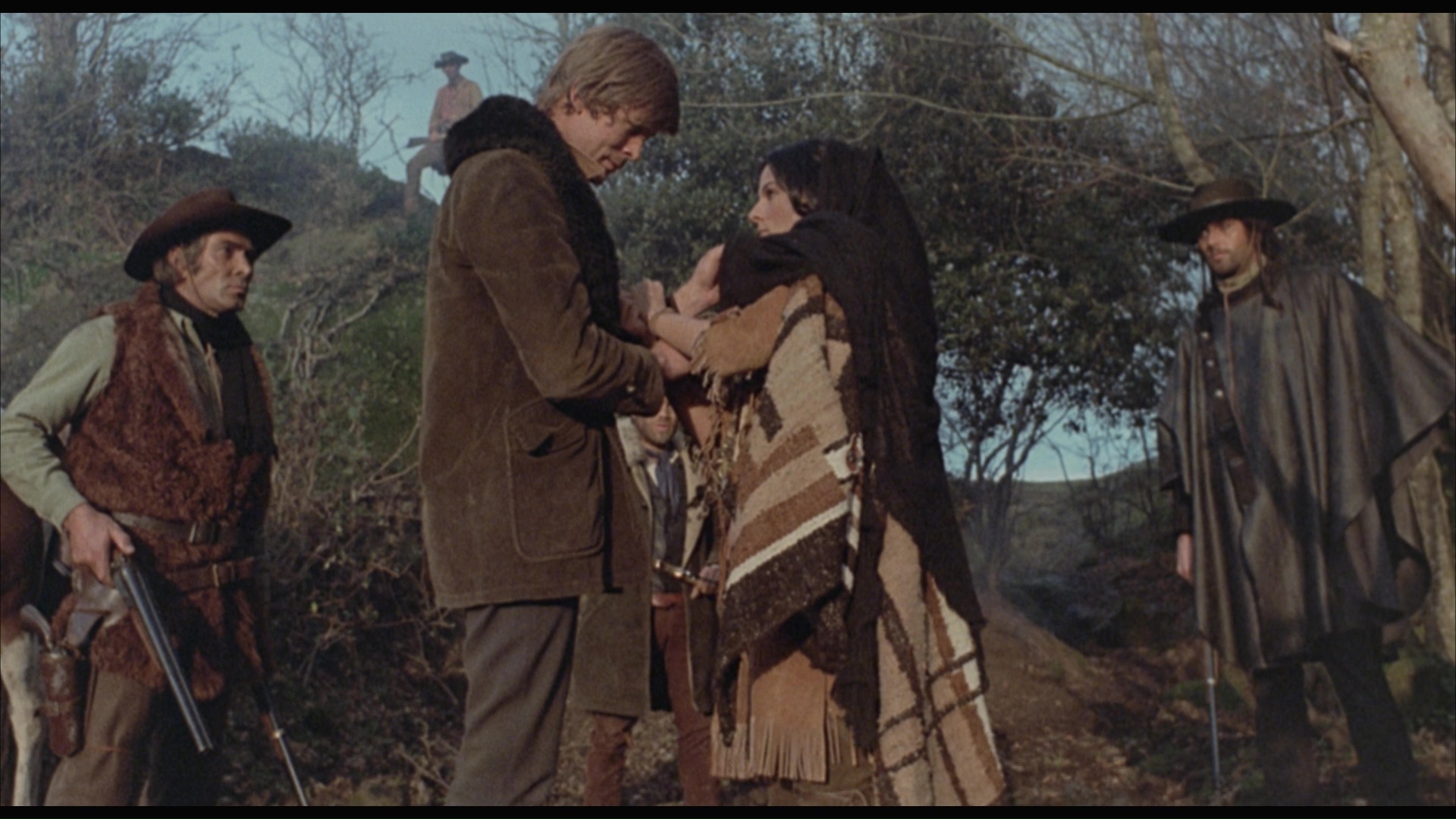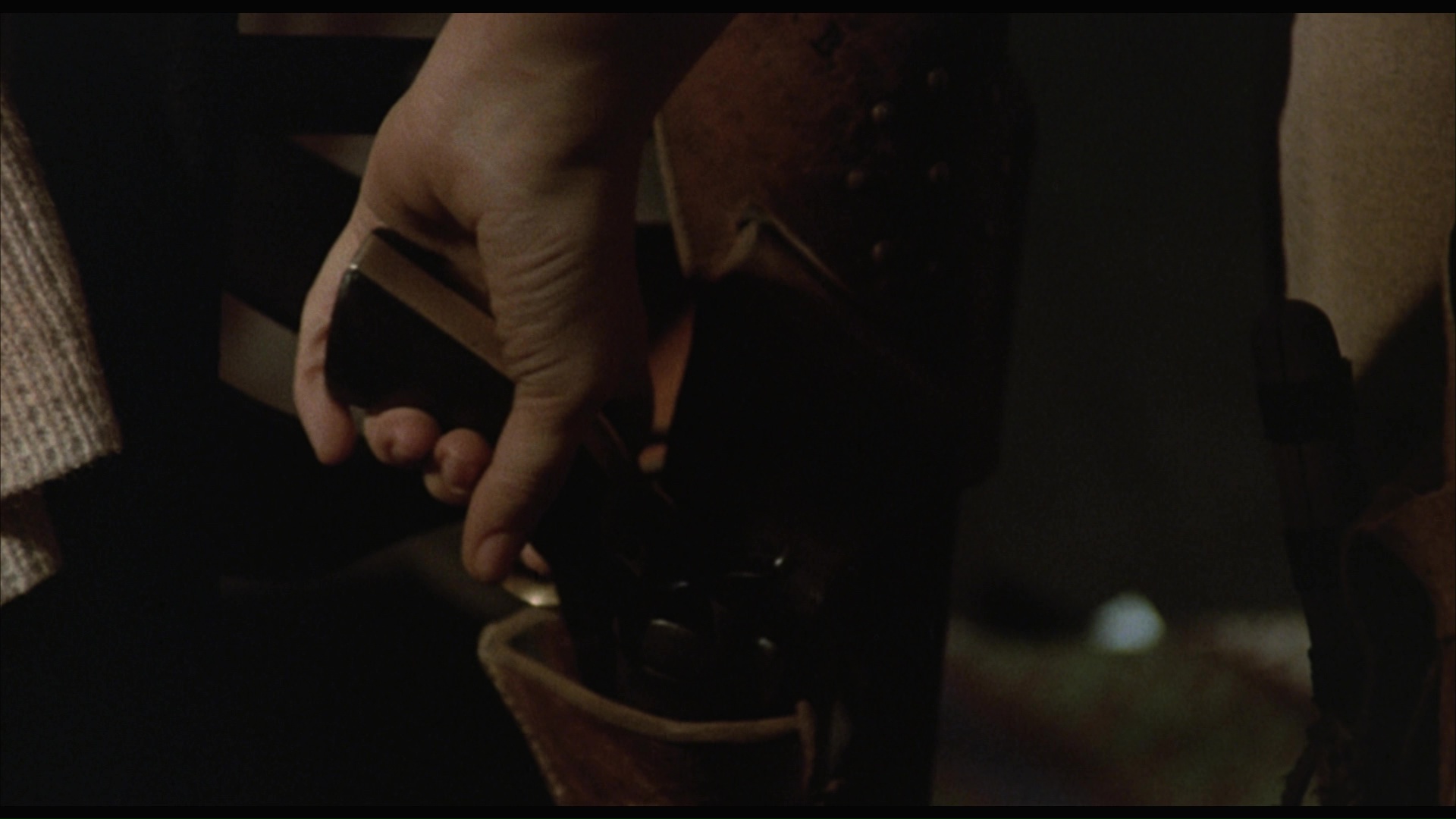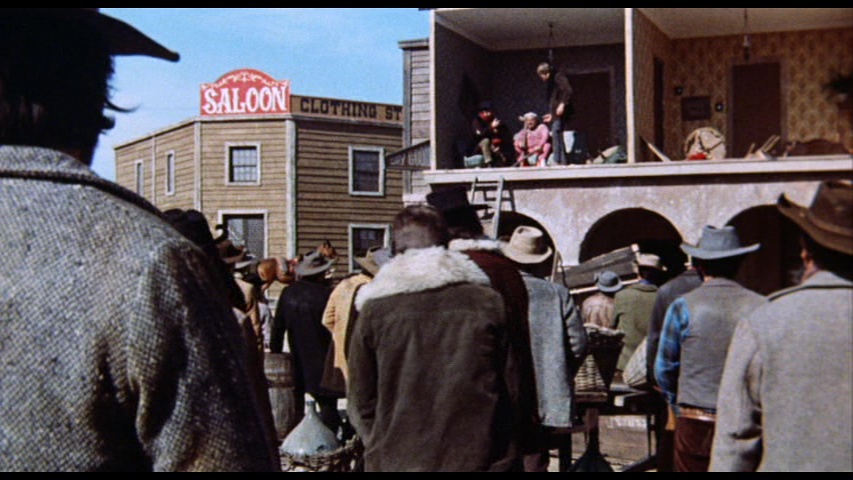

Color, 1970, 83 mins. 26 secs.
Directed by Mario Bava
Starring Brett Halsey, Charles Southwood, Marilù Tolo, Teodoro Corrà, Isa Miranda
Kino Lorber (Blu-ray & DVD) (US RA/R1 HD/NTSC), Anchor Bay, Image Entertainment (DVD) (US R1 NTSC) / WS (1.85:1) (16:9)
Though best  known as a director of
known as a director of  horror and suspense films, Mario Bava had no problem dipping his toes into everything from sword and sandal films to comic book adventures. Of course, he also had to try his hand at spaghetti westerns – twice, in fact, starting with the straightforward The Road to Fort Alamo in 1964. By the time he returned to wild west territory again with Roy Colt and Winchester Jack in 1970, he was stuck with a basic script by Five Dolls for an August Moon writer Mario di Nardo that he didn’t really like very much. What to do? Make it a comedy! The ensuing slapstick western is a real oddity, one that never appears anywhere near the top of fans’ lists of favorite Bava films but does act as a sort of fascinating one-off before he dove into more overtly violent, sexy territory in the '70s.
horror and suspense films, Mario Bava had no problem dipping his toes into everything from sword and sandal films to comic book adventures. Of course, he also had to try his hand at spaghetti westerns – twice, in fact, starting with the straightforward The Road to Fort Alamo in 1964. By the time he returned to wild west territory again with Roy Colt and Winchester Jack in 1970, he was stuck with a basic script by Five Dolls for an August Moon writer Mario di Nardo that he didn’t really like very much. What to do? Make it a comedy! The ensuing slapstick western is a real oddity, one that never appears anywhere near the top of fans’ lists of favorite Bava films but does act as a sort of fascinating one-off before he dove into more overtly violent, sexy territory in the '70s.
After years of riding together in a gang, Roy Colt (Halsey, also in Bava’s Four Times That Night a year later) has decided to lead a straight respectable life apart from Winchester Jack (Southwood). The emergence of a treasure map leading to a cache of gold causes their paths to repeatedly cross, however, often at cross purposes with Roy  intruding on Jack’s heist plans. Meanwhile Jack also hooks up with opportunistic Indian prostitute Maila (Tolo), and both men have to contend with a Russian, dynamite-loving Reverend (Corrà) who wants the stash all for himself.
intruding on Jack’s heist plans. Meanwhile Jack also hooks up with opportunistic Indian prostitute Maila (Tolo), and both men have to contend with a Russian, dynamite-loving Reverend (Corrà) who wants the stash all for himself.
A featherweight offering right from the start, this film benefits from fairly charismatic turns by the late Southwood (who only made a handful of westerns and had a minimal career) and Tolo, who manages to spin a bit of gold out of a thin role. Halsey has less to do and is mostly rigid through the film except for the moments he either teams up with or faces off against his co-star in typical love-hate buddy fashion, and as with a lot of his other Italian films, his heavy makeup (including really odd-looking eyebrows) can be very distracting. The slapstick comedy has been divisive among fans since this one first turned up in English-friendly editions, particularly a filler brawl scene at a brothel that at least allows Bava to indulge in some of the usual visual gags and flourishes that can be found in even his lesser films.
The exact release history of this film in English has been something of a mystery; while most spaghetti westerns were circulated in dubbed versions, this one doesn’t seem to have had much play in theaters  outside of its Italian version despite the creation of an English track for international sales. Almost any English speakers interested in the film didn’t have a chance to check it
outside of its Italian version despite the creation of an English track for international sales. Almost any English speakers interested in the film didn’t have a chance to check it  out until its 2001 DVD release from Image Entertainment as part of the company’s remarkable Bava line (mostly but not all licensed via Alfredo Leone), featuring a decent transfer at the time in Italian with English subtitles and a poster and stills gallery as the sole extra. The Italian mix is fine albeit really thin at times, barely doing justice to the catchy, amusingly anachronistic pop-western score by Piero Umiliani (who really outdid himself on Bava’s Five Dolls). Anchor Bay reissued the film in 2007 as part of the same batch of Bava titles, completely bare bones, as both a standalone disc and as part of its Mario Bava Collection: Volume 2 set devoted to the maestro’s '70s output.
out until its 2001 DVD release from Image Entertainment as part of the company’s remarkable Bava line (mostly but not all licensed via Alfredo Leone), featuring a decent transfer at the time in Italian with English subtitles and a poster and stills gallery as the sole extra. The Italian mix is fine albeit really thin at times, barely doing justice to the catchy, amusingly anachronistic pop-western score by Piero Umiliani (who really outdid himself on Bava’s Five Dolls). Anchor Bay reissued the film in 2007 as part of the same batch of Bava titles, completely bare bones, as both a standalone disc and as part of its Mario Bava Collection: Volume 2 set devoted to the maestro’s '70s output.
In 2017, Kino Lorber gave the film its third go-round on American home video with separate Blu-ray and DVD releases, featuring a fresh HD scan that wrings far more detail out of the film than past transfer ever indicated. Things like grass, wood, and clothing are much more tactile here, and it helps give the film a professional sheen that was sorely lacked before. The color timing differs from past releases, sometimes marginally (with a cooler look and less orange skin tones) and radically  during night scenes with a heavy blue tint present where natural warm studio lighting was present before. (Most notably, the nocturnal opening titles and Jack’s forced bathing
during night scenes with a heavy blue tint present where natural warm studio lighting was present before. (Most notably, the nocturnal opening titles and Jack’s forced bathing  scene at gunpoint are now much darker and moodier than before.) There’s also quite a bit more image info visible in the frame, especially on the right. The LPCM Italian mono track with optional English subtitles (which have an odd thin border around them) is par for the course if you’re familiar with how this film sounds, and in an interesting twist, the surviving passages from the English dub are included as well. The latter is basically worth checking out for curiosity value though as it doesn’t kick in until Chapter 5 (basically a third of the way through the film) and drops out a few times afterwards, with dead silence filling the rest of the track. It’s a pretty clumsy dub job considering the film was at least partially shot in English, barely even trying to match Halsey’s lip movements when he’s speaking. Much more satisfying is the new audio commentary by Mario Bava: All the Colors of the Dark’s Tim Lucas; if you’ve heard his Bava tracks before you know you’re in for a treat as he goes very, very deep into the details of the production including the di Nardo script, Halsey’s tenure in Italy, Bava’s reason for taking the film, Tolo’s modesty during her love scene (as opposed to Southwood, who flashes more than you’d expect for a 1970 western), the zero-budget ingenuity involved with some of Bava’s trademark visual experiments, and the film's status as a response to Sergio Leone as well as a foreshadowing of Duck, You Sucker! The sole video extra is the Italian intermission cards, which were present on past releases but have been set aside separately here.
scene at gunpoint are now much darker and moodier than before.) There’s also quite a bit more image info visible in the frame, especially on the right. The LPCM Italian mono track with optional English subtitles (which have an odd thin border around them) is par for the course if you’re familiar with how this film sounds, and in an interesting twist, the surviving passages from the English dub are included as well. The latter is basically worth checking out for curiosity value though as it doesn’t kick in until Chapter 5 (basically a third of the way through the film) and drops out a few times afterwards, with dead silence filling the rest of the track. It’s a pretty clumsy dub job considering the film was at least partially shot in English, barely even trying to match Halsey’s lip movements when he’s speaking. Much more satisfying is the new audio commentary by Mario Bava: All the Colors of the Dark’s Tim Lucas; if you’ve heard his Bava tracks before you know you’re in for a treat as he goes very, very deep into the details of the production including the di Nardo script, Halsey’s tenure in Italy, Bava’s reason for taking the film, Tolo’s modesty during her love scene (as opposed to Southwood, who flashes more than you’d expect for a 1970 western), the zero-budget ingenuity involved with some of Bava’s trademark visual experiments, and the film's status as a response to Sergio Leone as well as a foreshadowing of Duck, You Sucker! The sole video extra is the Italian intermission cards, which were present on past releases but have been set aside separately here.
ANCHOR BAY DVD





Reviewed on October 14, 2017.



 known as a director of
known as a director of  horror and suspense films, Mario Bava had no problem dipping his toes into everything from sword and sandal films to comic book adventures. Of course, he also had to try his hand at spaghetti westerns – twice, in fact, starting with the straightforward The Road to Fort Alamo in 1964. By the time he returned to wild west territory again with Roy Colt and Winchester Jack in 1970, he was stuck with a basic script by Five Dolls for an August Moon writer Mario di Nardo that he didn’t really like very much. What to do? Make it a comedy! The ensuing slapstick western is a real oddity, one that never appears anywhere near the top of fans’ lists of favorite Bava films but does act as a sort of fascinating one-off before he dove into more overtly violent, sexy territory in the '70s.
horror and suspense films, Mario Bava had no problem dipping his toes into everything from sword and sandal films to comic book adventures. Of course, he also had to try his hand at spaghetti westerns – twice, in fact, starting with the straightforward The Road to Fort Alamo in 1964. By the time he returned to wild west territory again with Roy Colt and Winchester Jack in 1970, he was stuck with a basic script by Five Dolls for an August Moon writer Mario di Nardo that he didn’t really like very much. What to do? Make it a comedy! The ensuing slapstick western is a real oddity, one that never appears anywhere near the top of fans’ lists of favorite Bava films but does act as a sort of fascinating one-off before he dove into more overtly violent, sexy territory in the '70s.  intruding on Jack’s heist plans. Meanwhile Jack also hooks up with opportunistic Indian prostitute Maila (Tolo), and both men have to contend with a Russian, dynamite-loving Reverend (Corrà) who wants the stash all for himself.
intruding on Jack’s heist plans. Meanwhile Jack also hooks up with opportunistic Indian prostitute Maila (Tolo), and both men have to contend with a Russian, dynamite-loving Reverend (Corrà) who wants the stash all for himself.
 outside of its Italian version despite the creation of an English track for international sales. Almost any English speakers interested in the film didn’t have a chance to check it
outside of its Italian version despite the creation of an English track for international sales. Almost any English speakers interested in the film didn’t have a chance to check it  out until its 2001 DVD release from Image Entertainment as part of the company’s remarkable Bava line (mostly but not all licensed via Alfredo Leone), featuring a decent transfer at the time in Italian with English subtitles and a poster and stills gallery as the sole extra. The Italian mix is fine albeit really thin at times, barely doing justice to the catchy, amusingly anachronistic pop-western score by Piero Umiliani (who really outdid himself on Bava’s Five Dolls). Anchor Bay reissued the film in 2007 as part of the same batch of Bava titles, completely bare bones, as both a standalone disc and as part of its Mario Bava Collection: Volume 2 set devoted to the maestro’s '70s output.
out until its 2001 DVD release from Image Entertainment as part of the company’s remarkable Bava line (mostly but not all licensed via Alfredo Leone), featuring a decent transfer at the time in Italian with English subtitles and a poster and stills gallery as the sole extra. The Italian mix is fine albeit really thin at times, barely doing justice to the catchy, amusingly anachronistic pop-western score by Piero Umiliani (who really outdid himself on Bava’s Five Dolls). Anchor Bay reissued the film in 2007 as part of the same batch of Bava titles, completely bare bones, as both a standalone disc and as part of its Mario Bava Collection: Volume 2 set devoted to the maestro’s '70s output.  during night scenes with a heavy blue tint present where natural warm studio lighting was present before. (Most notably, the nocturnal opening titles and Jack’s forced bathing
during night scenes with a heavy blue tint present where natural warm studio lighting was present before. (Most notably, the nocturnal opening titles and Jack’s forced bathing  scene at gunpoint are now much darker and moodier than before.) There’s also quite a bit more image info visible in the frame, especially on the right. The LPCM Italian mono track with optional English subtitles (which have an odd thin border around them) is par for the course if you’re familiar with how this film sounds, and in an interesting twist, the surviving passages from the English dub are included as well. The latter is basically worth checking out for curiosity value though as it doesn’t kick in until Chapter 5 (basically a third of the way through the film) and drops out a few times afterwards, with dead silence filling the rest of the track. It’s a pretty clumsy dub job considering the film was at least partially shot in English, barely even trying to match Halsey’s lip movements when he’s speaking. Much more satisfying is the new audio commentary by Mario Bava: All the Colors of the Dark’s Tim Lucas; if you’ve heard his Bava tracks before you know you’re in for a treat as he goes very, very deep into the details of the production including the di Nardo script, Halsey’s tenure in Italy, Bava’s reason for taking the film, Tolo’s modesty during her love scene (as opposed to Southwood, who flashes more than you’d expect for a 1970 western), the zero-budget ingenuity involved with some of Bava’s trademark visual experiments, and the film's status as a response to Sergio Leone as well as a foreshadowing of Duck, You Sucker! The sole video extra is the Italian intermission cards, which were present on past releases but have been set aside separately here.
scene at gunpoint are now much darker and moodier than before.) There’s also quite a bit more image info visible in the frame, especially on the right. The LPCM Italian mono track with optional English subtitles (which have an odd thin border around them) is par for the course if you’re familiar with how this film sounds, and in an interesting twist, the surviving passages from the English dub are included as well. The latter is basically worth checking out for curiosity value though as it doesn’t kick in until Chapter 5 (basically a third of the way through the film) and drops out a few times afterwards, with dead silence filling the rest of the track. It’s a pretty clumsy dub job considering the film was at least partially shot in English, barely even trying to match Halsey’s lip movements when he’s speaking. Much more satisfying is the new audio commentary by Mario Bava: All the Colors of the Dark’s Tim Lucas; if you’ve heard his Bava tracks before you know you’re in for a treat as he goes very, very deep into the details of the production including the di Nardo script, Halsey’s tenure in Italy, Bava’s reason for taking the film, Tolo’s modesty during her love scene (as opposed to Southwood, who flashes more than you’d expect for a 1970 western), the zero-budget ingenuity involved with some of Bava’s trademark visual experiments, and the film's status as a response to Sergio Leone as well as a foreshadowing of Duck, You Sucker! The sole video extra is the Italian intermission cards, which were present on past releases but have been set aside separately here. 



